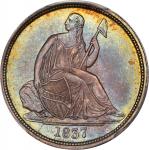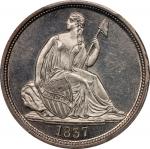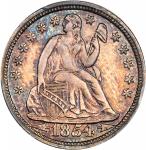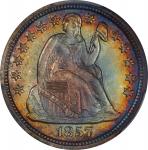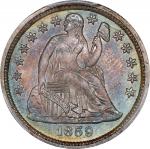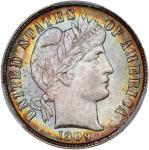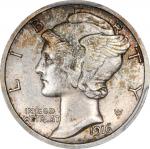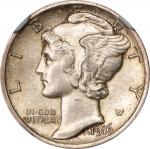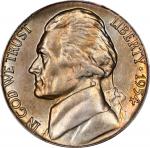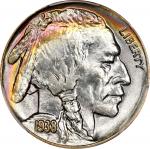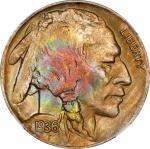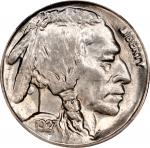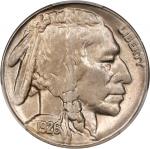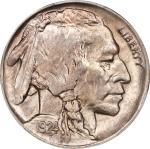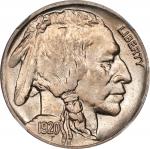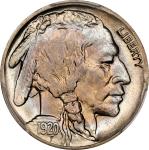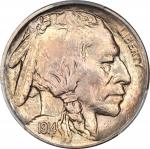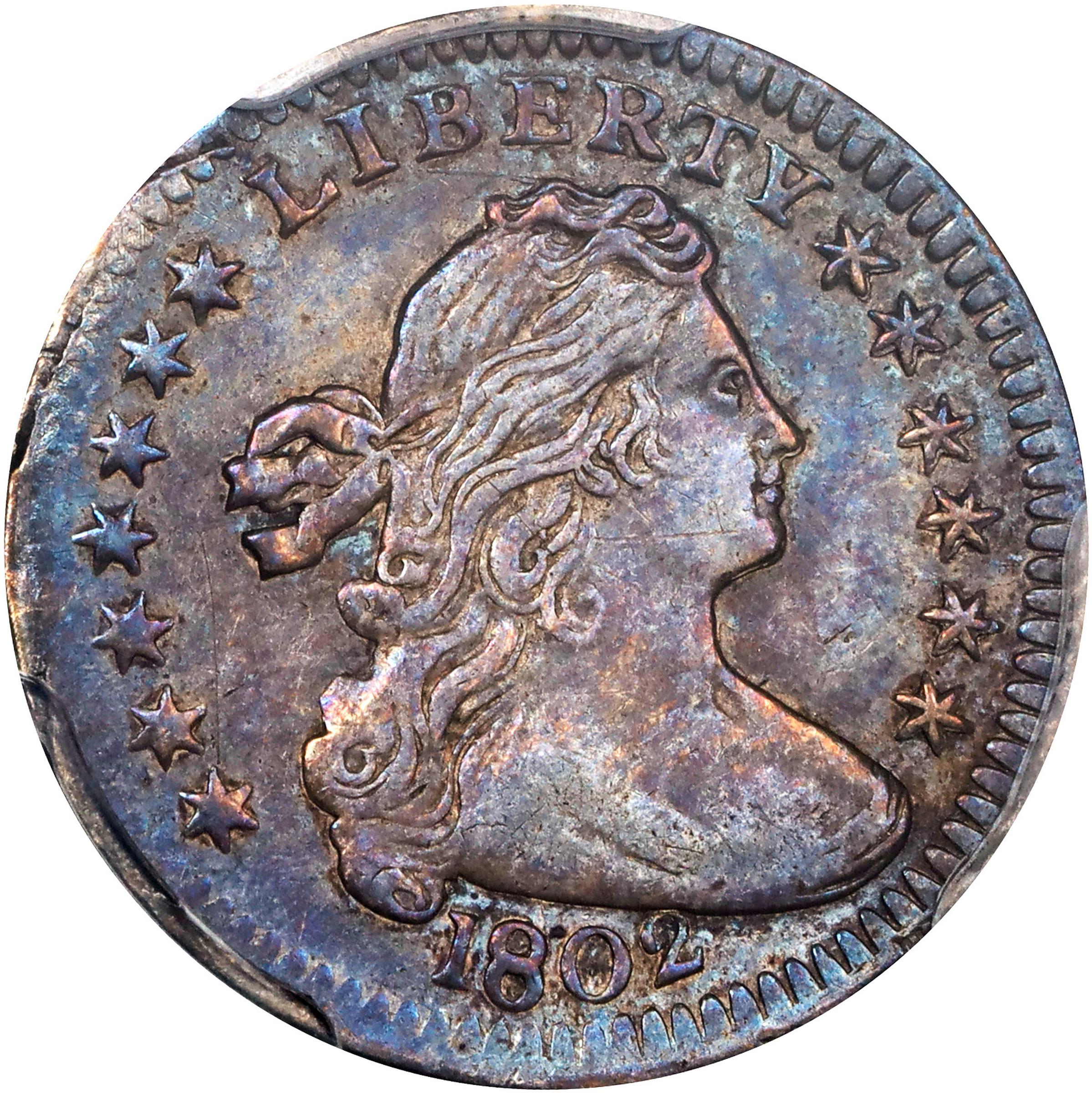1802 Draped Bust Half Dime. LM-1, the only known dies. Rarity-5. AU-50 (PCGS). CMQ. Beyond its status as the key date among all issues of the denomination, the 1802 half dime is a classic and the object of many collectors quests. Indeed, this was the very final piece of the puzzle for the D. Brent Pogue Collection, the single early American date that had eluded them in a grade that met their lofty demand for quality.
Perhaps the third finest extant, only clearly exceeded by the Newlin-Garrett coin, this coin far surpasses a typical 1802 half dime, nearly every example of which is damaged or in low grade. Only light wear is seen, and fine toning of violet-gray dominates both sides, with rich gold tracing the devices. Some light hairlines are noted under the toning, and a glass finds some minor evidence of handling. A short horizontal scratch is present low on Libertys jaw line, some shallow marks in the lower left obverse field, similarly shallow old worn scratches among the star and cloud cluster and above the eagle on the reverse. The strike is typical, a bit blunted on Libertys bust, soft on the lowest curls, somewhat ill-defined at the left side of the star cluster. The die state is also typical, with an unusual die crack above Libertys highest wave of hair to below the letter B in LIBERTY and a rim break above the letter E in UNITED. The grade and eye appeal, however, are entirely atypical.
That this is not a Gem Mint State coin like so many of the other half dimes in our May 2015 sale of the D. Brent Pogue Collection should not be a distraction, as no such 1802 half dime, nor anything close to it, exists. A long list could be composed of legendary collections that have never included a 1802 half dime, a list that would start with F.C.C. Boyd, whose "Worlds Greatest Collection" sale suffered from very few omissions from the era of the first U.S. Mint, beyond an 1802 half dime. David J. Davis has theorized that Boyd owned a counterfeit that was withdrawn before the 1945 auction, a sensible speculation.
The 1802 half dime has been the most famous issue in the entire half dime series since interest in it began shortly after the denominations production run ended. Harold P. Newlin wrote his monograph on the series in 1883, just 10 years after the Mint Act of 1873 ended the half dimes heyday. Rich with false modesty, he wrote in his preface that "the writer contributes the following article, entirely conscious that it possesses little or no merit, in the hope that it may awaken an interest in the subject, and that at no far distant day a numismatist, eminently better qualified for the work, will give to the fraternity the benefit of his researches." That challenge remained until Dr. Daniel W. Valentine picked up the gauntlet in 1931 and published an effort that would remain standard until 1998, a text that used this very coin to illustrate the series most famous rarity.
Newlin drew significant attention to the 1802 half dime, focusing on it in his 1883 monograph and attempting a census of known specimens (he found 16).
As noted in the "History of Bust Half Dime Collection," in the front matter of the Logan-McCloskey reference on this series, "nearly one-third of [Newlins] publication is devoted to this single date," and its fame only grew from there. Augustus Heaton, one-time president of the American Numismatic Association, included it in his poem about rare silver coins called "The Silver Barons." B. Max Mehl devoted an entire page to the 1802 half dime in his 1947 W.W. Neil sale, the sort of treatment he usually reserved for 1804 dollars, furthering the comparison by noting "the 1802 half-dime has always been considered as one of our very rarest of all U.S. silver coins, nearly in the same category as the 1804 dollar."
Through all this remarkable rise in fame, the Pogue specimen appears to have avoided much in the way of public notice. Its provenance begins with its publication in the Daniel W. Valentine work, the standard for more than a half century, with its earlier owners not known. Valentine could have acquired it from Wayte Raymonds 10th sale in 1926, which offered an example called "Fine"; no other specimen in any grade is known to have sold at auction between 1922 and the publication of Valentines monograph in 1931. The Pogue coin transacted privately for most of the 20th century until being discovered in a notable Virginia collection in 1999, trading through several dealer intermediaries, and finally emerging for its first auction appearance in 2006.
This remains one of the very finest known examples of this legendary rarity. It carries Coin Serial Number 104 in the late Dr. Jon P. Amatos <em>Numismatic Background and Census of 1802 Half Dimes</em> but, as above, in our opinion only the Newlin-Garrett coin (Amato-101) is a known finer example. PCGS# 38607. NGC ID: 2328. Ex advanced Virginia collector; John Feigenbaum and Jim McGuigan, by sale, June 1999, to Jonathan Kern; Heritages sale of the Steve Glenn Collection, April 2006 CSNS Signature Auction, lot 1868; Heritages sale of the Joseph C. Thomas Collection, April 2009 CSNS Signature Auction, lot 2186; Eugene H. Gardner; Heritages sale of the Eugene H. Gardner Collection, Part I, June 2014, lot 30180; D. Brent Pogue Collection; our (in conjunction with Sothebys) sale of the D. Brent Pogue Collection, Part I, May 2015, lot 1013. Plated in Dr. Daniel W. Valentines <em>The United States Half Dimes</em> in 1931.







